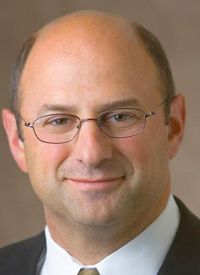New Hodgkin Lymphoma Therapy in the Pipeline
Adcetris (brentuximab vedotin) was granted a breakthrough therapy designation by the Food and Drug Administration (FDA) for the frontline treatment of patients who have classical Hodgkin lymphoma
Clay Siegall, PhD

Clay Siegall, Ph.D.
Adcetris (brentuximab vedotin) was granted a breakthrough therapy designation by the Food and Drug Administration (FDA) for the frontline treatment of patients who have classical Hodgkin lymphoma, according to Seattle Genetics, the company developing the antibody-drug conjugate.
Now that the drug has a breakthrough therapy designation, the FDA will expedite its review and development.
Adcetris is an antibody-drug conjugate directed to CD30, a defining marker of the disease. The designation is based on phase 3 results from the ECHELON-1 clinical trial, which were released in June.
The two-year rate of modified progression-free survival (PFS) for Adcetris plus AVD (adriamycin, vinblastine, dacarbazine) was 82.1 percent compared with 77.2 percent for patients receiving ABVD (adriamycin, bleomycin, vinblastine, dacarbazine). The experimental combination reduced the risk of disease progression or death by 23 percent. An interim analysis of two-year overall survival (OS) also showed a trend favoring the Adcetris arm.
“The phase 3 ECHELON-1 study that supports the breakthrough therapy designation for [brentuximab vedotin] in combination with chemotherapy showed superior activity versus the standard of care chemotherapy regimen in the treatment of frontline advanced classical Hodgkin lymphoma patients,” Clay Siegall, Ph.D., president and CEO of Seattle Genetics, said in a press release. “The decision by the FDA to grant this designation recognizes the need for new options that can change the care of people with newly diagnosed advanced Hodgkin lymphoma. The designation supports our goal to make Adcetris available to patients in this setting as soon as possible.”
The company plans to present full data at the 2017 ASH Annual Meeting in December.
ECHELON-1 is a global, multicenter trial of 1334 patients with a histologically confirmed diagnosis of stage 3 or 4 classical Hodgkin lymphoma who had not been previously treated with systemic chemotherapy or radiotherapy. Study sites included medical facilities on every continent except Antarctica.
The primary endpoint is modified PFS per independent review facility assessment using the Revised Response Criteria for Malignant Lymphoma. Modified PFS is defined as the time to progression, death or receipt of additional anti-cancer therapy for patients who are not in complete response after completion of frontline therapy.
The combination of Adcetris and AVD showed promising objective response rates (ORR) in phase I results from 47 patients presented at the 2012 ASH Annual Meeting. Long-term follow-up data presented at the 2014 ASH Annual Meeting demonstrated three-year OS was 100 percent and three-year failure-free survival was 96 percent.
In the 2012 results, patients (51 patients) received doses of 0.6, 0.9, or 1.2 mg/kg of Adcetris with standard doses of ABVD or 1.2 mg/kg of Adcetris with AVD, depending upon cohort assignment. The combination regimens were administered on days one and 15 of each 28-day cycle for up to six cycles of therapy. At baseline, 45 percent of all patients had stage 4 Hodgkin lymphoma, 25 percent had an IPS score of 4 or higher, and all patients with available ECOG status had a score of 0 or 1.
Six patients received 0.6 mg/kg of Adcetris, 13 received 0.9 mg/kg, and six received 1.2 mg/kg with ABVD. Twenty-six patients received 1.2 mg/kg Adcetris with AVD. There was no dose-limiting toxicity observed in either regimen up to a dose of 1.2 mg/kg to Adcetris.
Each regimen was evaluated for a dose-limiting toxicity period, defined as any cycle 1 toxicity requiring a delay of at least seven days in standard ABVD or AVD therapy. Determination of antitumor activity was based on investigator assessment of objective response according to the Revised Response Criteria for Malignant Lymphoma. FDG-PET interpretation for cycle 2 was performed by a central review per Deauville criteria with uptake above liver background considered positive.
The overall ORR was 96 percent. At the end of frontline therapy, 95 percent of patients assigned to Adcetris plus ABVD had complete response (CR) and 92 percent of those assigned to Adcetris plus AVD patients had a CR. One patient in the Adcetris plus AVD arm had a partial response and one had progressive disease.
One patient in the Adcetris plus ABVD arm died of hyponatremia and pulmonary toxicity. Overall, seven patients discontinued Adcetris due to an adverse event (AE; five in the ABVD arm and two in the AVD arm).
Common AEs (20 percent of patients or more overall) in the ABVD and AVD groups, respectively, included nausea (76 percent, 77 percent), neutropenia (80 percent, 69 percent), peripheral sensory neuropathy (72 percent, 65 percent), vomiting (60 percent, 38 percent), fatigue (44 percent, 46 percent) and constipation (48 percent, 31 percent).
Common grade 3 or higher AEs (10 percent or more of patients) observed in the Adcetris plus ABVD and Adcetris plus AVD cohorts, respectively, included neutropenia (80 percent vs 65 percent), anemia (20 percent vs 12 percent), febrile neutropenia (20 percent vs 8 percent) and pulmonary toxicity (24 percent vs 0 percent).
In the ABVD cohort, 44 percent of patients experienced pulmonary toxicity, interstitial lung disease, or pneumonitis that led to discontinuation of bleomycin. Two of these events led to death. Of these patients, seven completed treatment with AVD and Adcetris. In general, these events occurred between cycles 3 and 6.
Investigators did not observe any pulmonary toxicity in the Adcetris plus AVD cohort. The incidence of neuropathy was similar between the ABVD (72 percent) and AVD (73 percent) regimens, and none of these events were grade 4 or higher in severity.